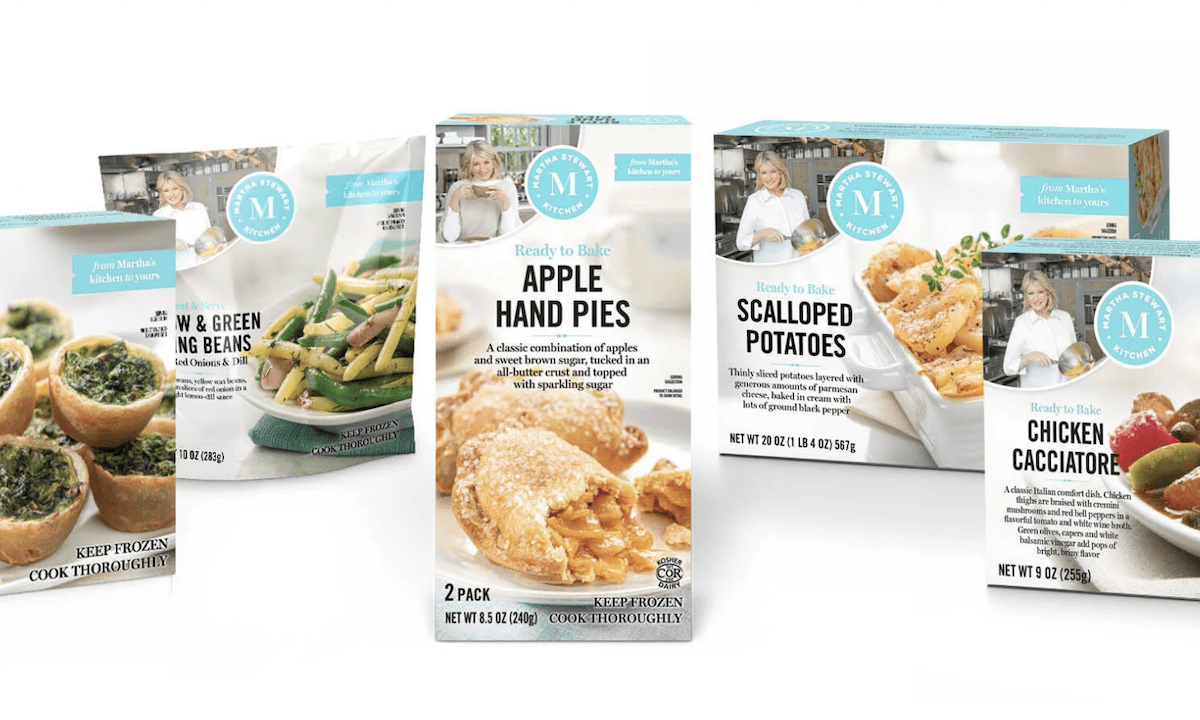Martha Stewart Aims To Take On Every Aisle Of The Grocery Store

After 40 years of trying to teach us how to cook, Martha Stewart has finally given up on us. Well, not exactly, because the recipe arm of her media brand is still very active, but at least she is offering us an easy out. The Martha Stewart Kitchen line of frozen foods has launched at more than 7,000 stores with more than 40 SKUs already available, and it will increase to 10,000 by the end of the month.
“If you’re going by points of distribution, I think we’ve got the biggest launch maybe ever,” Ken Venturi, CEO of MSK Foods, told PYMNTS in an interview. “And we’re not done — we’re still continuing to launch new products throughout the holiday season and into 2022. We’ve got a pretty massive new business.”
The line includes frozen appetizers, sides, entrees and desserts, all based on previously published Martha Stewart recipes. In the future, the company plans to expand beyond the frozen food section into other aisles of the grocery store.
Marketing First, Food Second
The brand is a subsidiary of Venturi’s Mediacast Holdings, an investment holding company with a focus on marketing, in partnership with brand owner and marketer Marquee Brands. Venturi describes it as an “entrepreneurial organization that has roots in product launches, marketing and media,” noting that this focus made these companies a good fit for Stewart, who built her empire on her media expertise.
The Martha Stewart Kitchen brand effectively describes a media company that works with a wide range of food manufacturers, rather than describing a company that creates the food itself. As both an investor and a media agency, Venturi noted that Mediacast has more incentive to stick the landing on marketing the launch than a traditional agency, in which the worst-case scenario would be getting fired from the account. He added, “If it’s not working, it’s not about us getting fired. It’s about us fixing it and making it work.”
The Frozen Food Opportunity
The brand was not conceived as a frozen food company. Rather, the company saw that there was a significant opportunity in frozen foods, and subsequently chose to begin the launch of Martha Stewart Kitchen in the freezer aisle.
“We had a retailer tell us that the category hadn’t changed since 1994,” said Venturi. “So we did a significant gap analysis of where we thought the retailer and the consumer were ready to move into some new, higher quality, higher experiential type of products, and the frozen category was definitely front and center.”
He added that the incumbent brands in the space “are kind of stale,” and that they primarily aim to offer the lowest prices without focusing as much on quality or on products’ health benefits, leaving room for higher-end newcomers to gain share in the category among consumers looking for a more premium experience.
“Folks have been eating at home for the last year and a half — they’re kind of burned out on all of that same stuff,” said Venturi, adding that these products present a “step up” for consumers who don’t have time to prepare dinner from scratch but who want a “home-cooked quality meal.”
Taking on Takeout
As the restaurant and grocery categories run together, with consumers increasingly eating restaurant meals at home and expecting online grocery shipments to arrive as quickly as their pizza deliveries, the question of who is competing with whom is becoming more complicated. Rather than viewing the brand’s products as in competition with incumbent frozen food brands or with raw groceries, Venturi sees these products as competing with off-premise restaurant meals.
See also: Ultra-Fast Food Delivery Drives Up Consumers’ Bring-it-to-Me Expectations
“I don’t know that the mom of a family of five is going to not make dinner because she’s going to serve all frozen Martha, but we want to be that option for them,” said Venturi. “So the idea is to have … a restaurant-quality meal out of the freezer section.”
He noted that the frozen food category as a whole grew dramatically in 2020, and he predicts that it will continue to grow in the years ahead, gaining share from restaurants. Reflecting on last year, he added, “I do believe that growth came straight out of the restaurants, and we’ll probably have some halo effect. We’ll continue to see that for a while.”
Martha Stewart, Empress Of Food
Combined, Stewart’s products bring in about $900 million in revenue each year across categories, which Venturi takes as a sign that Stewart’s brand is “tremendously versatile and high-ranging,” leaving room to expand into all manner of grocery categories. He added that the move to begin with frozen food is the brand’s “conquest strategy,” which he defines as “just be somewhere where you’re noticeable.”
Now, after establishing the brand’s reputation in the freezer aisle, the goal is to expand the line further and further out, working with manufacturers across categories to hugely broaden the scope of Stewart’s brand.
“We don’t see why she can’t have soups and dressings and baking mixes and fresh bakery and deli — down the line, we think we will put her in just about every product,” said Venturi. “We have a long, controlled growth model. But ultimately, we see her being very versatile across multiple aisles in the grocery store and the mass retailer.”